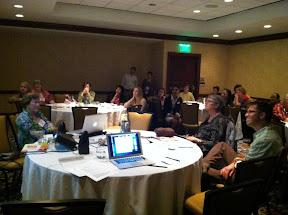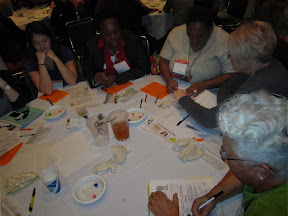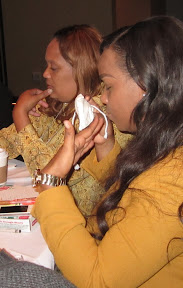Did I meet you at the NAEYC 2012 conference in Atlanta this month? I met many early childhood educators who are interested in some of the same questions I find most interesting, such as “What science topics are appropriate to teach about in early childhood and at which age?” and “How can I move a class from making beginning observations to collecting data and thinking about it again and again as we do activities that focus on one concept?”
The sessions did a lot to answer my questions. Here is information about just a few of them. Feel free to add information about your session or those you attended as a comment below.
 Betty Zan and Sonia Yoshizawa of the University of Northern Iowa presented “More Ramps and Pathways: An approach to teaching physical science and engineering in early childhood.” The session was described on the NAEYC 2012 annual conference itinerary planner as:
Betty Zan and Sonia Yoshizawa of the University of Northern Iowa presented “More Ramps and Pathways: An approach to teaching physical science and engineering in early childhood.” The session was described on the NAEYC 2012 annual conference itinerary planner as:
 Ramps and Pathways is a physical science activity involving inclined planes and the movement of objects that is both developmentally appropriate and intellectually rigorous. An integration of physical science and design, engineering, and technology, it appeals to the children’s interests and desires to figure out how the physical world works and to modify the physical world to make something interesting happen…..Participants will use marbles, objects that roll and do not roll, and lengths of cove moldings to build ramp structures and investigate the movement of marbles and other objects on inclined planes. They will have an opportunity to explore force and motion, by using the ramps materials to investigate the movement of objects on inclines…. Participants will learn how to use Ramps and Pathways activities to promote children’s development of practical understanding of force and motion, design, and engineering habits of mind. Videos of children using the materials in the classrooms and teachers interacting with children will illustrate principles of teaching that will guide teachers in setting up the environment, intervening in ways that promote the higher-order thinking, and supporting children’s active investigation.
Ramps and Pathways is a physical science activity involving inclined planes and the movement of objects that is both developmentally appropriate and intellectually rigorous. An integration of physical science and design, engineering, and technology, it appeals to the children’s interests and desires to figure out how the physical world works and to modify the physical world to make something interesting happen…..Participants will use marbles, objects that roll and do not roll, and lengths of cove moldings to build ramp structures and investigate the movement of marbles and other objects on inclined planes. They will have an opportunity to explore force and motion, by using the ramps materials to investigate the movement of objects on inclines…. Participants will learn how to use Ramps and Pathways activities to promote children’s development of practical understanding of force and motion, design, and engineering habits of mind. Videos of children using the materials in the classrooms and teachers interacting with children will illustrate principles of teaching that will guide teachers in setting up the environment, intervening in ways that promote the higher-order thinking, and supporting children’s active investigation.
As I walked around the room I saw participating teachers making modifications to their ramp structures again and again as they learned through experience AND discussion with others in their group what changes were needed to make the ramp “work” (carry a marble or other object to the end, around a corner, or into a cup). We were learning how to use productive questions to guide our students to persist and discover the changes that would help them achieve their plan.
Some resources for learning more about this investigation:
- ¨Ramps & Pathways: a constructivist approach to physics with young children” by Rheta DeVries, and C. Sales, (2011). Washington, DC: National Association for the Education of Young Children.
- Q&A with the authors of Ramps & Pathways book“, Rheta DeVries and Christina Sales
- “The Right Question At The Right Time” by J. Elstgeest, in Primary Science: Taking the Plunge (second edition). (2001). Portsmouth, NH: Heinemann.
- “Ramps and Pathways: Developmentally Appropriate, Intellectually Rigorous, and Fun Physical Science” by Betty Zan and Rosemary Geiken NAEYC journal, Young Children, January 2010.
- “Problem Solving and Physics in Preschool” by Julie Stoll, Ashley Ann Hamilton, Emilie Oxley, Angela Mitroff Eastmand, and Rachel Brent. 2012. Young Children 67 (2): 20-26
- “Revealing the Work of Young Engineers in Early Childhood Education” by Beth Van Meeteren and Betty Zan, SEED Papers: Published Fall 2010, University of Northern Iowa
- “The Early Years: Drawing Movement” by Peggy Ashbrook. November 2012. Science and Children 50 (3): 30-31. (I wrote about how children use and develop their visual literacy skills when they try to represent their ramp structures in drawings. Describing the motion of an object is tricky on paper but the children found ways to represent it with symbols and writing.)
Some related lesson plans and video:
- ¨Peep and the Big Wide World, Unit 6 Explore Ramps, http://www.peepandthebigwideworld.com/guide/pdf/peep-guide-ramps.pdf
- ¨Annenberg Foundation, Eight free professional development videos for K-8 teachers, (or parents!) presenting science concepts in force and motion. http://www.learner.org/workshops/force/ (Note that the links may not work but the videos are still available.) 1. Making an Impact, 2. Drag Races, 3. When Rubber Meets the Road, 4. On a Roll, 5. Keep on Rolling, 6. Force Against Force, 7. The Lure of Magnetism, 8. Bend and Stretch
Children learn best when they feel safe to explore and question. The CEASE/LGBT Interest Forum collaborative session, ” ‘That’s so gay’: Reviewing language and teaching tolerance” presented by Steven Shuman, Sharon Davisson and Brian Silviera gave us time for discussion as we learned about tools for supporting children in resolving conflicts, and tools to educate ourselves about using gender neutral language. Their handouts will help us share information on how saying “girls and boys” or lining up by gender “draws children’s attention to gender — rather than other more important characteristics of individuals within classroom settings, such as their personalities or skills,” and how to create peaceable classrooms with our programs.

How could I pass up a session titled “Lunar picnic with preschoolers and their families: Exploring the moon and related classroom activities” by pre-k teacher Judy Brown from Dyer County Tennessee? We learned how she arranged for her students to journal with their families about their nighttime moon observations, and to have a telescope night. The journaling activity became a ritual for some families, much like a routine emotional connection. The well-thought out system of providing materials weekly and keeping a page for parent comments and feedback next to the sign-in sheet led to all families participating to some degree. Classroom discussion included emphasizing that the moon appears to change but does not actually change shape, respecting children’s ideas while helping them consider alternative explanations. Read her article with Satomi Izumi-Taylor in the Spring/Summer 2009 issue of Dimensions of Early Childhood, “Sciencing with Young Children: Moon Journals!” While the moon is not something that children can experience hands-on or change in any way, it is a source of wonder and a subject for rich imaginative play.
 “Finding the trees in the forest: Support todders’ developing problem-solving skills” addressed an age group that isn’t often considered in science education. Through discussion and viewing video vignettes, Rosemary Geiken took us into her study of how toddlers problem solve with “containers and contents.” We saw how children ages 12-24 months figure out how to navigate through space, how objects fit together, and begin to develop spatial reasoning and geometrical thinking. Dr. Geiken encouraged us to recognize that sometimes the best support a teacher can offer is to let children work on their own and avoid putting our goals on the child’s play. By planning what materials to add or take away, we can help children solve a problem, reach a goal, and get new challenges.
“Finding the trees in the forest: Support todders’ developing problem-solving skills” addressed an age group that isn’t often considered in science education. Through discussion and viewing video vignettes, Rosemary Geiken took us into her study of how toddlers problem solve with “containers and contents.” We saw how children ages 12-24 months figure out how to navigate through space, how objects fit together, and begin to develop spatial reasoning and geometrical thinking. Dr. Geiken encouraged us to recognize that sometimes the best support a teacher can offer is to let children work on their own and avoid putting our goals on the child’s play. By planning what materials to add or take away, we can help children solve a problem, reach a goal, and get new challenges.
 The Early Childhood Science Interest Forum (ECSIF) held the second annual meeting for all interested people. We all introduced ourselves and then viewed and discussed video of a 2nd grade classroom where the students met to talk and investigate butterfly lifecycle, with the teacher exemplifying best practice as she got the children to ask questions and talk about their ideas.
The Early Childhood Science Interest Forum (ECSIF) held the second annual meeting for all interested people. We all introduced ourselves and then viewed and discussed video of a 2nd grade classroom where the students met to talk and investigate butterfly lifecycle, with the teacher exemplifying best practice as she got the children to ask questions and talk about their ideas.
The National Science Teachers Association has appointed a committee to draft a position statement for that organization on teaching science in early childhood. We had hoped that NAEYC would participate and make it a joint position statement but the two organizations are on different schedules.
The ECSIF is planning to develop criteria to review books about the broad topic of teaching science inquiry in early childhood. We hope to publish the reviews of books that we feel will best support early childhood educators in developing science inquiry and science practices in their programs.
The meeting wasn’t long enough to do a year’s worth of talk so we’ll continue the conversations on social media. Join us even if you didn’t get to the meeting.
- NAEYC Interest Forum pages– www.naeyc.org/IF
- ECSIF Blog – http://ecsif.blogspot.com/
- ECSIF Facebook page – Early Childhood Science Interest Forum (naeyc)
- http://www.facebook.com/pages/Early-Childhood-Science-Interest-Forum-naeyc/140431919391071
- ECSIF Pinterest page – http://pinterest.com/ecsif/
- ECSIF Twitter page – https://twitter.com/ECSIF
- ECSIF email: naeyc.ecsif@gmail.com
Thanks to NAEYC for bringing the expertise of early childhood educators together so we could have these conversations and learning experiences. And thank you to those who participated in the session I presented with Science and Children Editor Linda Froschauer. Look at how engaged they were as they took part in a science inquiry about gumballs and recorded their predictions and data, and practiced how to “whiff and waft” the smells of unknown materials towards them as they used their sense of smell to guess what the materials were (lemon, cinnamon sticks, onion and cof
fee beans).















 In my sixth grade science class, I try to involve the students in fun activities. But they don’t take them seriously unless I require something in writing or give a quiz. And then the students don’t seem to be able to connect the activity with the content. What can I do?
In my sixth grade science class, I try to involve the students in fun activities. But they don’t take them seriously unless I require something in writing or give a quiz. And then the students don’t seem to be able to connect the activity with the content. What can I do?